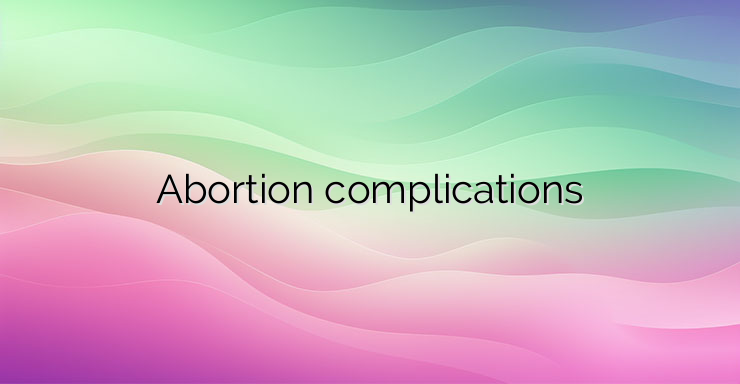Approximately one million abortions are performed each year in Europe alone. Although considered safe, therapeutic abortions, like miscarriages, can lead to various complications. Most complications are considered minor such as pain, bleeding, infection and post-anesthesia complications. Others are major, including uterine atony and subsequent hemorrhage, uterine perforation, injuries to adjacent organs (bladder or bowel), cervical laceration, failed abortion, septic abortion, and disseminated intravascular coagulation (DIC). Complications after abortion develop as a result of three main mechanisms: 1. Infection; 2. Incomplete evacuation of the products of conception, which leads to a hemorrhagic complication; 3. Injury from the surgical procedure itself. The frequency and severity of abortion complications depend on the gestational age and the method of abortion. Comprehensive abortion care is included in the list of essential health services published by WHO in 2020. Abortion is a simple health intervention that can be effectively managed by a wide range of health workers using medication or a surgical procedure. During the first 12 weeks of pregnancy, medical abortion can be safely self-administered by the pregnant woman outside the health facility (eg at home), in whole or in part. This requires that the woman has access to accurate information, quality medicines. Comprehensive abortion care includes information provision, abortion management and post-abortion care. It covers care related to miscarriage, induced abortion (deliberate termination of an ongoing pregnancy by medical or surgical means), incomplete abortion, as well as fetal death (intrauterine death of the fetus). Lack of access to safe, affordable, and timely abortion care and abortion-related stigma pose risks to women’s physical and mental well-being across the lifespan. Each year, 4.7-13.2% of female deaths can be attributed to unsafe abortion. Physical health risks associated with unsafe abortion include: Incomplete abortion (inability to remove or expel all pregnancy tissue from the uterus); Haemorrhage (heavy bleeding); Infection; Perforation of the uterus; Damage to the genital tract and internal organs as a result of inserting dangerous objects into the vagina or anus. There are three main mechanisms by which abortion complications can be classified. Infection can result from failure to practice universal preprocedural precautions such as hand washing, use of surgical gloves, proper field sterilization, use of nonsterile instruments, and the presence of a prior infectious process in the patient such as cervicitis or endometritis. Incomplete evacuation of the products of conception leads to pooling of blood in the uterus, causing hyperdistension and atony, leading to hemorrhage.It can also lead to infection and possible sepsis. Injury from the surgical procedure itself depends on the method used and includes vaginal or cervical lacerations, as well as injury to the uterus, bowel, or bladder. References: 1. Bearak J, Popinchalk A, Ganatra B, Moller AB, Tunçalp Ö, Beavin C et al. Unintended pregnancy and abortion by income, region, and the legal status of abortion: estimates from a comprehensive model for 1990–2019. 2. Ganatra B, Gerdts C, Rossier C, Johnson Jr BR, Tuncalp Ö, Assifi A et al. Global, regional, and subregional classification of abortions by safety, 2010–14: estimates from a Bayesian hierarchical model. The Lancet. 2017 3. Say L, Chou D, Gemmill A, Tunçalp Ö, Moller AB, Daniels J et al. Global causes of maternal death: a WHO systematic analysis. Lancet Glob Health. 2014 Jun; 2(6):e323-33. 4. Singh S, Maddow-Zimet I. Facility-based treatment for medical complications resulting from unsafe pregnancy termination in the developing world, 2012: a review of evidence from 26 countries. BJOG 2015; published online Aug 19. DOI:10.1111/1471-0528.13552. 5. Coast E, Lattof SR, Meulen Rodgers YV, Moore B, Poss C. The microeconomics of abortion: A scoping review and analysis of the economic consequences for abortion care-seekers.


Leave a Reply